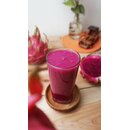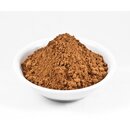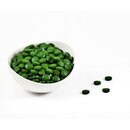Wild blueberries (bilberries) from Canada.
Frozen, shipping only via "frozen goods by postal mail"
1 kg wild blueberries Vaccinium Angustifolium from the still wild areas of Canada, individually rolled and frozen.
Thanks to the gentle shock freezing, all valuable substances are retained.
Our delicious dark purple blueberries offer more than just the delicious taste.
What our grandparents already knew: it helps against diarrhea and inflammation in the mouth (this mainly applies to dried organic blueberries). But that's not all. The wild blueberry in particular is known for the prevention of cardiovascular diseases, as nerve protection, for the health of blood vessels, for normalizing blood sugar and digestion.
Hardly any other fruit (apart from acai or purple corn) is as deep, dark purple as the wild blueberry. The colour derives from the anthocyanins in it, and they are powerful antiaging agents because they attack the free radicals. These antioxidants inhibit bacteria, fungi and viruses.
Portionizing
Open the bag while it is still frozen, remove the desired number of blueberries. Close the bag with a clip and put it back in the freezer.
In contrast to cultivated blueberries, the health-promoting blue pigment permeates the entire berry in wild blueberries, whereas in cultivated blueberries it is only in the skin. Wild blueberries are much more aromatic.
The blueberry belongs to the heather family (Ericaceae). The berries ripen in late summer and the remains of the flowers form a crater so that the blueberry is not quite spherical.
Active ingredients in blueberries
The presumably active components in blueberries are pigments: they belong to the group of anthocyanins - a very diverse class that provides black, bluish, reddish and purple colors in fruits and flowers. Chemically speaking, anthocyanins belong to the polyphenols. In addition to anthocyanins, blueberries also contain other polyphenols.
Competition of pigments
The highest levels of anthocyanins are found in apple, elderberry and blueberry. After consumption, the colorings also pass into the blood. After six hours, however, there is time for more supplies. Then the anthocyanins in the blood are used up.
Blueberry polyphenols are potent oxidants
A common characteristic of polyphenols is their ability to scavenge reactive oxygen species (ROS). Therefore, oxidative damage is averted from the cells, that is the "antioxidative" effect. Oxidative processes are involved in the development of many health disorders and diseases, including cardiovascular diseases, cancer, chronic inflammation, neurodegeneration and aging.
In addition, polyphenols can interact with all proteins (hydrogen bonds and ionic bonds). This can have a positive effect: if you have diarrhea in the intestine, for example, a final layer forms on the mucous membrane, which strengthens the intestinal barrier. In addition, polyphenols fight invaders such as bacteria, fungi and viruses.
Blueberries: a classic against diarrhea for the whole family
While larger amounts of fresh fruit are more easily removed, dried blueberries and an Infusion of tem have a slightly constipating effect in the case of diarrhea. As the effect is gentle they are equally suitable for children and adults.
Diabetes
The blueberry is one of the oldest traditional remedies for diabetes 2.
It promotes the release of insulin and increases the absorption of sugar by the muscles and fat cells. The blood sugar level in mice was successfully lowered with an extract from the blueberry. In addition, test animals gained less fat on a high-fat diet, presumably the bilberry reduces the absorption of fat in the intestine. In addition, a changed metabolism in the fat cells can also be detected.
Except for traditional experiences, there are no decisive human studies.
Inflammation
Cell culture experiments prove it: The blue anthocyanins, the other polyphenols and the blueberry infusion have extremely positive effects on inflammation. They reduce the production of heating-up messenger substances.
Tests on humans followed with positive results: for example, corresponding blood parameters improved in a risk group for cardiovascular diseases. 330ml blueberries were consumed over a four-week period.
Studies have also reported success with mild forms of inflammatory bowel disease such as ulcerative colitis. The tradition recommends blueberries locally for inflammation of the mouth and throat mucosa and for the treatment of hemorrhoids. The berries help with ulcers (including stomach ulcers) and are said to support wound healing. In addition, the anthocyanin extract seals the veins and prevents swelling or edema.
100% sun-ripened wild blueberries
- no additives
- GMO free
- allergen-free
- gluten free
The fruits are picked sun-ripened, processed freshly harvested and conserved thanks to deep-freezing and without any additives. Aroma, taste and ingredients are optimally preserved. It could not be fresher.
With the addition of juices, milk or even yoghurt, blueberries can be used to quickly and easily mix fresh, healthy premium smoothies and extravagant fruit drinks. But they are also suitable for the preparation of ice cream, patisserie products, cocktails or sauces. There are no limits for your creativity.
Preparation:
Put some blueberries in blender with Acai or other juices (especially delicious with coco), milk and / or yogurt to make fresh, healthy fruit drinks, smoothies, sherbets or shakes.
Cardiovascular
In the past, blueberries were recommended to improve cardiovascular function.
In fact, an extract enriched with anthocyanins dilates blood vessels and lowers blood pressure. An antithrombotic effect has also been proven: in the experiment, the blood platelets had a lower tendency to clump. The anti-inflammatory contribution of anthocyanins protects the vessels from arteriosclerosis. In animal experiments, at least, anthocyanins were used to limit the damage by interrupting the blood supply. This is potentially relevant for heart attacks and strokes.
Nerves love blue
Anthocyanins are absorbed in the intestine and can cross the blood-brain barrier, a prerequisite for an effect on the brain. In experimental animals, a diet rich in berries led to an increased occurrence of more branched nerve cells and increased cell division in certain areas of the brain.
Nerve disorders as Parkinson's also respond experimentally to the blue anthocyanins in berries
People who have often resorted to blue berries in their lifetime have a lower risk of developing Parkinson's. An analysis of the eating habits of 130,000 participants found that the Parkinson's rate at the Berry Fan Club was about 25% lower. The pigments obviously not only inhibit the breakdown of dopamine, but also protects the nerve cells. This is crucial because in Parkinson's disease, nerve cells that produce the neurotransmitter dopamine die. This then leads to disruption of movement and even paralysis.
Does Blue make you smart?
Not quite. But rats benefited from abundant berry food in the areas of balance and coordination as well as memory. In humans, too, this diet should be relevant as a remedy for age- or disease-specific deterioration in nerve function (movement and intellect).
Alzheimer
In Alzheimer's disease, the destruction of the nerve cells is causally linked to the progression of the disease. Here, too, the blue berries scored, and also reduced inflammatory processes that contribute to the clinical picture. At least in mice, the mental degradation remained low, but not all neurocognitive tests were better.
Initial tests on humans show a positive tendency with slight cognitive losses. Between 360 and 500 ml of berry juice were consumed per day (calculated for a body weight of 60 kg).
Blue against the blues
Anthocyanins and related substances from blue berries lift the mood. Cell culture experiments have shown this: the happiness hormone serotonin is broken down more slowly. The animal experiment with mice confirms the finding: the mice behaved less anxiously.
Blue for night vision
The traditional claims of improved visual performance through blueberries were also followed up. The extract does not improve the night vision of healthy test persons, but people who tire quickly and then experience eye problems such as burning or pressure benefit from the blueberry.
Various studies on eye diseases (cataract, retinopathy, macular degeneration and night blindness) are already available, but with very different outcomes. The results are positive, but the informative value is limited because the quality of the study was not optimal or mixtures of substances were used.
But one thing can be said: blueberry extract protects visual pigments, optic nerves and cells of the cornea. The blueberry could also contribute to the avoidance of cataracts, diabetic retinopathy and age-related visual impairment.
Antibacterial
It has long been known that many berries are effective against bacteria. The blueberry is no exception: a positive profile of action on the intestinal bacteria Salmonella and the pus pathogen Staphylococcus aureus has been confirmed. But since there is only an inhibiting effect on growth - and not a bactericidal effect - their contribution is relatively weak.
But there is another component: like the cranberry, the blueberry juice prevented the bacteria from adhering to human cells, as demonstrated by an experiment with the causative agent of pneumonia Streptococcus pneumoniae or the agent of meningitis Neisseria meningitidis. This not only weakens the pathogenicity but also promotes the elimination of the attackers. One must say, however, that these are laboratory tests. Whether it has any clinical relevance remains to be seen.
Anti-cancer and anti-aging berries: "chemoprevention" with pigments
Numerous laboratory tests focused on the topic of cancer prevention, with the blueberry doing well. It was said to have protective properties with regard to the development of cancer (anti-inflammatory, antioxidant) as well as the progression of an already manifest cancer (inhibition of cell division, promotion of regulated cell death) and inhibition of the blood supply to the tumor (anti-angiogenic). The findings cannot be transferred directly to humans, but there is sufficient evidence from animal and laboratory tests that would justify studies with anthocyanins in humans.
Since the anthocyanins can also prevent damage to the genetic material of the cells, the blueberry could also make a contribution to an antiaging diet.
Side effects & contraindications
There are no known side effects or interactions of the blueberry.
Contents
Tannins: proanthocyanidin and catechin types (up to 12%)
blue-violet dyes: anthocyanins such as delphinidin, petunidin, malvidin and cyanidin
Flavonoids: quercetin glycosides, hyperoside, isoquercitrin and quercitrin and the kaempferol glycoside astragaline
Triterpenes: ursolic acid
Iridoid glycosides: asperuloside, monotropein (only unripe fruits)
organic acids, phenol carboxylic acids
Vitamins: C and B1 and B2, pantothenic acid, nicotinamide
| Shipping weight: | 1,00 Kg |
| Product weight: | 1,00 Kg |
| Contents: | 1,00 kg |




